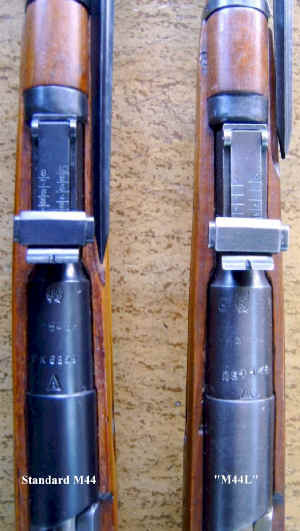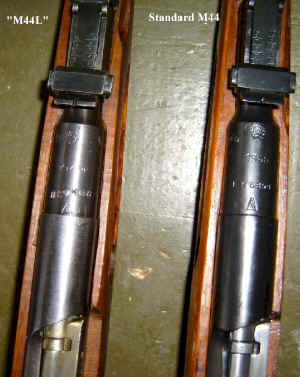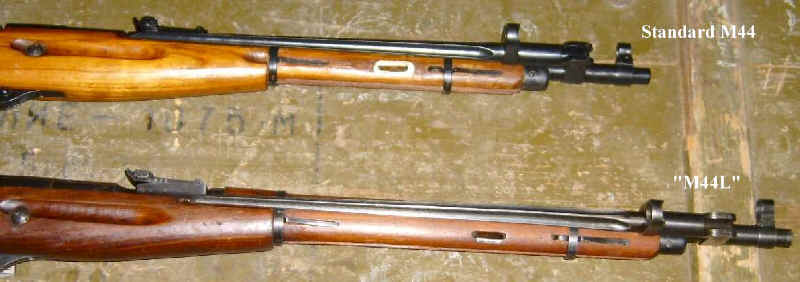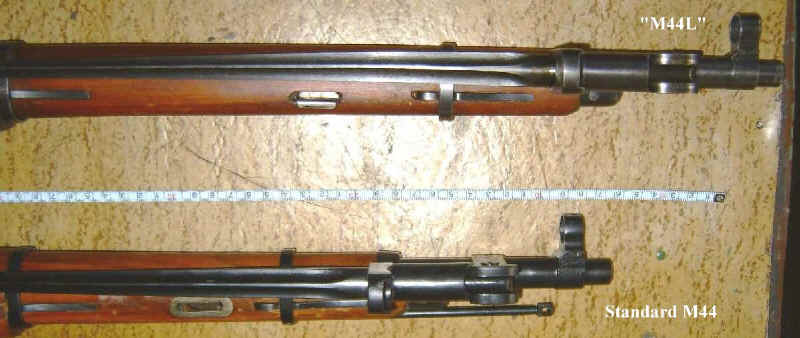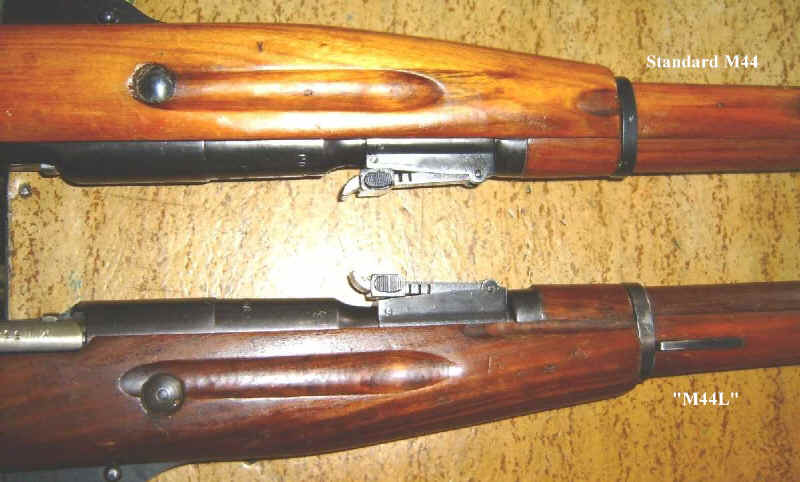All content copyright © 7.62x54r.net
| Comparison of M44, M44L and M91/30 Specifications | ||||
| Model | M44 | M44L | Difference M44/M44L |
M91/30 |
| Weight | 9 lbs. 4.1 kg. |
9 1/2 lbs. (4) 4.3 kg. |
1/2 lbs. 0.2 kg. |
8 3/4 lbs.(5) 4 kg. |
| Overall Length (1) | 40" 101.6 cm. |
43 3/4" 111.0 cm. |
3 3/4" 9.4 cm. |
48 1/2" 123.2 cm. |
| Barrel Length (2) | 20 1/4" 51.4 cm. |
24" 60.8 cm. |
3 3/4" 9.4 cm. |
28 3/4" 73 cm. |
| Stock Length | 36 1/2" 92.7 cm. |
40 1/4" 102.1 cm. |
3 3/4" 9.4 cm. |
45" 114.3 cm. |
| Sight Radius | 16 1/2" 41.9 cm. |
20 1/4" 51.3 cm. |
3 3/4" 9.4 cm. |
24 1/2" 62.2 cm. |
| Bayonet Length (3) | 12 1/4" 31.0 cm. |
13 3/4" 34.7 cm. |
1 1/2" 3.7 cm. |
17" 43.2 cm. |
(1) Bayonet
stowed |
||||
The rifle pictured is a 1945 Izhevsk as "most" of these are reported to be. However, there are several possible scenarios on the origin. First, and most obvious, is that they were built towards the end or shortly after WWII at Izhevsk but discontinued after only a few thousand and later given or sold to Bulgaria. The second possibility is that completed M91/30s from 1945, which are very uncommon on the US collector's market, were cut down in the Soviet Union and had the bayonet added on a limited basis. Third, complete M91/30s, or M91/30 barreled actions, were given or sold to Bulgaria who later cut them down and added the bayonet. Without information from Bulgaria or the former Soviet Union, or an opportunity to examine several of the rifles first hand, it's impossible to say with any certainty if these scenarios, or even other possibilities, are the source of the rifles. There are several things that can be learned from the pictures though. Besides the aforementioned Izhevsk arsenal and 1945 date on the barrel, the receiver is a high wall, which is typical of 1945 Soviet production. This is confirmed by the Izhevsk arsenal mark and 1945r date on the receiver tang. The rear sight is of the same style as used on M38s and M44s with a short leaf and a sleeve type base. The M91/30 uses a base which fits on a dovetail machined into the barrel. It seems unlikely that the dovetail would be removed to install the sleeve type base.
The bayonet is longer than a standard M44 bayonet so would have been new production for these rifles. Because of the locking system it's not likely that M91/30 bayonets were cut down. The bayonet lug is the double ear type which was first used in late 1945 and the front sight base is the narrow type which was last used in 1946. This particular combination was only manufactured for a year or less and in the immediate post WWII era. The handguard has the longer rear section of the carbines and is the typical length in relation to the stock itself. No other model handguard could be cut down to this configuration so they were made for this rifle. The rifle shows even wear across the metal and so was apparently issued for a time, most likely in it's current configuration.
The stock has the same features as wartime Soviet production with only a liner in the front sling slot and no rear barrel band finger groove. While it would be simple enough to cut down the nose and add the abbreviated bayonet groove, an original M91/30 front sling slot would be in approximately the same location as the front barrel band spring. This is a good indication that the stocks are new production. The wartime features point towards the Soviet Union as the source, however some Eastern European stocks, notably Polish, also have some "wartime" features. The wood itself seems to have a more open grain and resembles the beech stocks of Eastern Europe, however with only one example it's impossible to know if this is typical or just normal deviation. Although the bayonet is longer than an M44 it is not in the same proportion as the barrel and therefore does not extend as far to the rear when folded. The cleaning rod is missing but the stock appears to have the typical channel.
The sling slots relationship to the front barrel band is midway between that of the M44 and M91/30.
The longer bayonet is apparent when it is extended.
The finger grooves seem to have the same offset from left to right as the Soviet stocks.
Taking all the features into consideration this rifle has the appearance of 1945 Soviet production just as the barrel and receiver markings indicate. However, until more information is available either from Bulgaria or in the form of the rifles themselves a final pronouncement will have to wait.
All content copyright © 7.62x54r.net |

